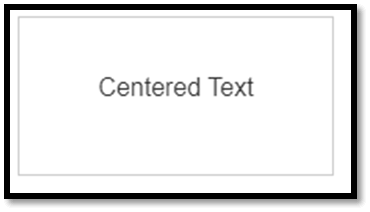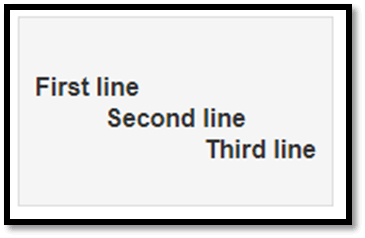CSS Text AnchorCascading Style Sheets (CSS) play a crucial role in web development by allowing developers to style and design the appearance of their web pages. One essential aspect of CSS is text styling, and among the numerous properties available, the CSS text-anchor property stands out. In this article, we'll explore what CSS text anchors are, how they work, and how they can be used to enhance the presentation of text on a website. CSS Text Anchor BasicsThe CSS text-anchor property is primarily associated with SVG (Scalable Vector Graphics) and defines the alignment of text within a text container. This property influences how the text is positioned relative to a given point or area, providing control over its placement. Syntax:The basic syntax for the text-anchor property is as follows:
Understanding Text Anchor Values: 1. Start:The "start" value aligns the text to the beginning of the text container. In English and many other left-to-right languages, this is the left side of the container. Code: Output: 
2. Middle:The "middle" value centers the text within the text container, ensuring an equal distribution on both sides. Code: Output: 
3. End:The "end" value aligns the text to the end of the text container. In left-to-right languages, this is the right side of the container. Code: Output: 
4. Inherit:The "inherit" value allows the text-anchor property to inherit its value from the parent element. Code: Output: 
Practical Applications1. SVG Elements:The text-anchor property is commonly used in SVG elements to control the alignment of text within shapes or containers. For example, in a bar chart, you should align the data labels to the end of each bar. Code: Output: 
Advanced Usage and Considerations1. Multiple Lines and Text Spans:When dealing with multiline text or text spans within a container, the text-anchor property can be applied individually to each text element. This allows for fine-grained control over the alignment of each line or span, enhancing the overall visual hierarchy. Code: Output: 
1. Browser Compatibility: When using the text-anchor property, it's essential to consider browser compatibility. While widely supported in modern browsers, some older browsers might still need to support it fully. Always check compatibility tables or use feature detection methods to ensure a consistent experience across different browsers. 2. Accessibility Considerations: When implementing text anchors, it's crucial to consider accessibility. Users with disabilities may rely on assistive technologies that interpret the visual presentation of content. Testing and ensuring that the text remains legible and understandable when a text anchor is applied is essential for an inclusive web experience. 3. Animations and Transitions: Text anchors can be integrated into animations and transitions, providing a smooth and visually engaging user experience. For example, transitioning between different text-anchor values can be used to create dynamic text movements or to respond to user interactions. Advantages of CSS Text Anchor1. Enhanced Visual Consistency: By utilizing the text-anchor property, developers can ensure a consistent and visually pleasing alignment of text within containers. This is particularly beneficial for maintaining a polished appearance across various elements on a web page. 2. Improved Readability: Proper text alignment is crucial for readability. Text anchored to the start, middle, or end of a container can enhance the overall reading experience, making it easier for users to follow the content. 3. Responsive Design Support: Text anchors are valuable in responsive web design. They allow developers to adapt text alignment based on the available space or screen size, ensuring that the presentation remains optimal across different devices and screen resolutions. 4. Fine-grained Control: Text anchors provide fine-grained control over the alignment of individual text elements within a container. This allows developers to create intricate layouts and hierarchies, especially in scenarios involving multiline text or text spans. 5. Dynamic Text Layouts: When combined with CSS transformations, text-anchor enables the creation of dynamic and interactive text layouts. This is useful for animations, transitions, and other effects that respond to user interactions, providing a more engaging user experience. Disadvantages of CSS Text Anchor1. Limited Browser Support in Some Cases: While widely supported in modern browsers, the text-anchor property might only partially be supported in some cases, especially in older browsers. Developers need to be aware of this limitation and employ fallbacks or alternative solutions when necessary. 2. Potential Accessibility Challenges: Implementing text anchors requires careful consideration of accessibility. If text-anchor values are not appropriately managed, users relying on assistive technologies may experience challenges. Ensuring that text remains legible and understandable is crucial for an inclusive web experience. 3. Complexity in Implementation: In certain scenarios, combining text anchors with other CSS properties for advanced layouts or animations can introduce complexity to the implementation. This complexity might make the code harder to maintain or troubleshoot, particularly for developers who need to become more familiar with these techniques. 4. Learning Curve for Beginners: For beginners in web development, understanding how to use text anchors effectively and combining them with transformations might pose a learning curve. Mastery of these techniques requires practice and a solid understanding of CSS concepts. 5. Impact on Page Load Time: Implementing intricate text layouts or animations using text anchors and other CSS properties may increase page load times. Developers should balance visual enhancements with considerations for website performance to ensure a smooth user experience. Applications of CSS Text Anchor in Web Development1. Data Visualizations: CSS text anchors are frequently employed in data visualizations, such as charts and graphs, where precise alignment of data labels is crucial. By using text-anchor values, developers can ensure that labels align appropriately with data points, enhancing the clarity and interpretability of the visualized information. 2. Responsive Typography: In responsive web design, text-anchor plays a role in adjusting text alignment based on the available screen space. This is particularly useful when designing layouts that need to adapt to different screen sizes, ensuring a consistent and visually appealing presentation of text. 3. Navigation Menus: Navigation menus often benefit from text anchors to control the alignment of menu items. This is especially important for horizontal or vertical menus, where aligning text to the start, middle, or end of the container contributes to a well-organized and visually appealing navigation structure. 4. Interactive Maps: When creating interactive maps using SVG, developers can leverage text anchors to align labels associated with geographic features. This enhances the readability of map annotations and ensures that labels are appropriately positioned relative to the corresponding locations. 5. Multimedia Overlays: Text anchors are valuable in multimedia overlays, such as image captions or video subtitles. By strategically applying text-anchor values, developers can control the positioning of text elements within overlay containers, creating a visually pleasing and user-friendly experience. 6. Animated Text Elements: CSS text anchors can be integrated into animations and transitions, adding a dynamic element to text on a webpage. This is commonly used in interactive applications, providing a visually engaging experience as text elements respond to user interactions or other events. 7. Form Design: In web forms, especially those with complex layouts, text anchors help align labels, input fields, and other form elements. This helps maintain a structured and organized appearance, improving the overall user experience during data input. 8. E-commerce Product Listings: E-commerce websites often utilize CSS text anchors to align product names and descriptions within product listings. This ensures a neat and consistent layout, making it easier for users to browse and compare products. 9. Brand Identity: Web pages that focus on brand identity and aesthetics leverage text anchors to control the alignment of taglines, slogans, or other key textual elements. This contributes to a cohesive and visually appealing representation of the brand. ConclusionIncorporating the CSS text-anchor property into your web development toolkit offers a range of possibilities for text alignment and presentation. Whether you are working on data visualizations, responsive layouts, or interactive applications, understanding the nuances of text anchors and their advanced usage can significantly contribute to creating visually appealing and user-friendly web pages. Experimenting with different values and combining them with other CSS properties opens up a realm of creative opportunities for developers.
Next TopicCSS Rotate Animation
|
 For Videos Join Our Youtube Channel: Join Now
For Videos Join Our Youtube Channel: Join Now
Feedback
- Send your Feedback to [email protected]
Help Others, Please Share










